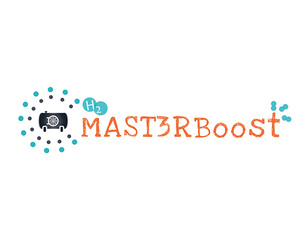MAST3RBoost
The project:
MAST3RBoost is a European project which aims to provide a solid benchmark of cold-adsorbed H2 storage (CAH2) at low compression (100 bar or below) by maturation of a new generation of ultraporous materials (Activated carbons, ACs, and Metal Organic Frameworks, MOFs) for mobility applications, i.e., H2-powered vehicles, including road and railway, air-borne and water-borne transportation.
Carbon dioxide emissions are a problem across the world and a big part of them are produced among the transport sectors. In Europe they constitute already one third of all CO2 emissions with over 1,000 million tons, representing a big threat for human health as well as one of the largest contributions to the climate change. Decarbonization of the economy and, in this case, of the transport sector is urgent. There have been improvements with the Fuel Cells and Hydrogen (FCH) batteries, which have proven to be a promising solution for the decarbonization of trucks, buses, ships, trains, or large cars. With the larger vehicles being potential early adopters, this new industry has the potential to generate a 130 billion € market in the European Union alone.
The problem is that, at the moment, the state-of-the-art technology for Hydrogen storage on board based on compression at 700bar, has reached 25 gH2/lsys ([2]), a number which is still low considering that the market-entry goal is to fit 5 kg of H2 in a gasoline equivalent tank (80 kg/90 l). In fact, the complexities associated to an efficient H2 storage are causing a very slow penetration of Fuel Cell Electric Vehicles (FCEVs). MAST3RBoost’s goal is to reach at least 40 gH2/Lsys, which is a significant milestone that would help to provide the market with an actual FCEV replacement to the current internal combustion engines, which are big contributors to the EU’s greenhouse gas emissions.
Based on a new generation of Machine Learning-improved ultraporous materials – such as Activated Carbons (ACs) and high-density MOFs –, MAST3RBoost project will enable a disruptive path to meet the industry goals by developing the first worldwide adsorption-based demonstrator at the kg-scale. Lightweight vessels – embedding the ultraporous materials – will be created taking advantage of the innovative Wire-Arc Additive Manufacturing, with dedicated shapes to better fit on-board specific transportation spaces.
Recycled raw materials for the manufacturing of the ultraporous materials will be actively pursued, both from waste agroforestry biomass and from solid urban waste. The research and development process will be performed applying Life Cycle thinking strategies to minimise overall environmental impacts and improve economic performance of the hydrogen storage system from the design phase. This project is funded in the topic HORIZON-CL4-2021-RESILIENCE-01-17 by the European Health and Digital Executive Agency. It is a Research and Innovation Action project with a budget of 4,638,414.00 €, 100% funded by the EU.
CIDETEC’S role in the project:
CIDETEC Surface Engineering is technical collaborating in two WPs: WP4 – Development and testing of advance, fibre-reinforced lightweight metal alloys and coatings for hydrogen storage vessel and WP5 – Design of vessel and ancillary components, digital twin, and integration of short-term hydrogen storage system. CIDETEC will select the best deposition conditions for different light alloys substrates developed by LKR (up to 5 different materials) with the coatings systems selected (some organic coatings applied by spraying and/or anaphoretic e-coatings). All coated samples will be pre-screened based on the adhesion and performance to near cryogenic conditions for prolonged time. Subsequently, the manufacturing of a suitable storage demonstrator will include the outcomes from the best coating systems selected. Additionally, CIDETEC is participating in WP1 – Development of data collection and storage infrastructure for application of machine-learning tools, WP6 – Life Cycle Assessment, Life Cycle Costing, and overall Risk Assessment & WP7 – Exploitation, Dissemination and Communication.
[1]gH2/lPS: grams of hydrogen stored per litre of adsorbent material under “Pressure Swing” conditions (100 bar to 5 bar)
[2]gH2/lsys: grams of hydrogen stored per litre of complete system including vessel and balance of plant under actual operation regime

Start: 01 | 06 | 2022
End: 31 | 05 | 2026
Budget: 4.638.414 €
Envirohemp S.L. (Spain) (Coordinador)
Contactica S.L. (Spain)
Agencia Estatal Consejo Superior de Investigaciones Científicas (Spain)
CIDETEC Surface Engineering (Spain)
Spike Renewables SRL (Italy)
EDAG Engineering GMBH (Germany)
Nanolayers OU (Estonia)
LKR Leichtmetall Kompetenzzentrum Ranshofen GMBH (Austria)
University of Pretoria (South Africa)
Council For Scientific and Industrial Research (South Africa)
Stellantis (old PSA Groupe) (Portugal)
TWI (UK)
University of Nottingham (UK)
Financiator
Funded by the European Union. Views and opinions expressed are however those of the author(s) only and do not necessarily reflect those of the European Union or European Commission. Neither the European Union nor the granting authority can be held responsible for them.
Publications
Leaflet MAST3RBoost
DownloadSectors
- Automotive
Technological fields
- There are no technological fields
Related news
CIDETEC Surface Engineering develops new sustainable materials for the hydrogen sector
22 de July de 2022












